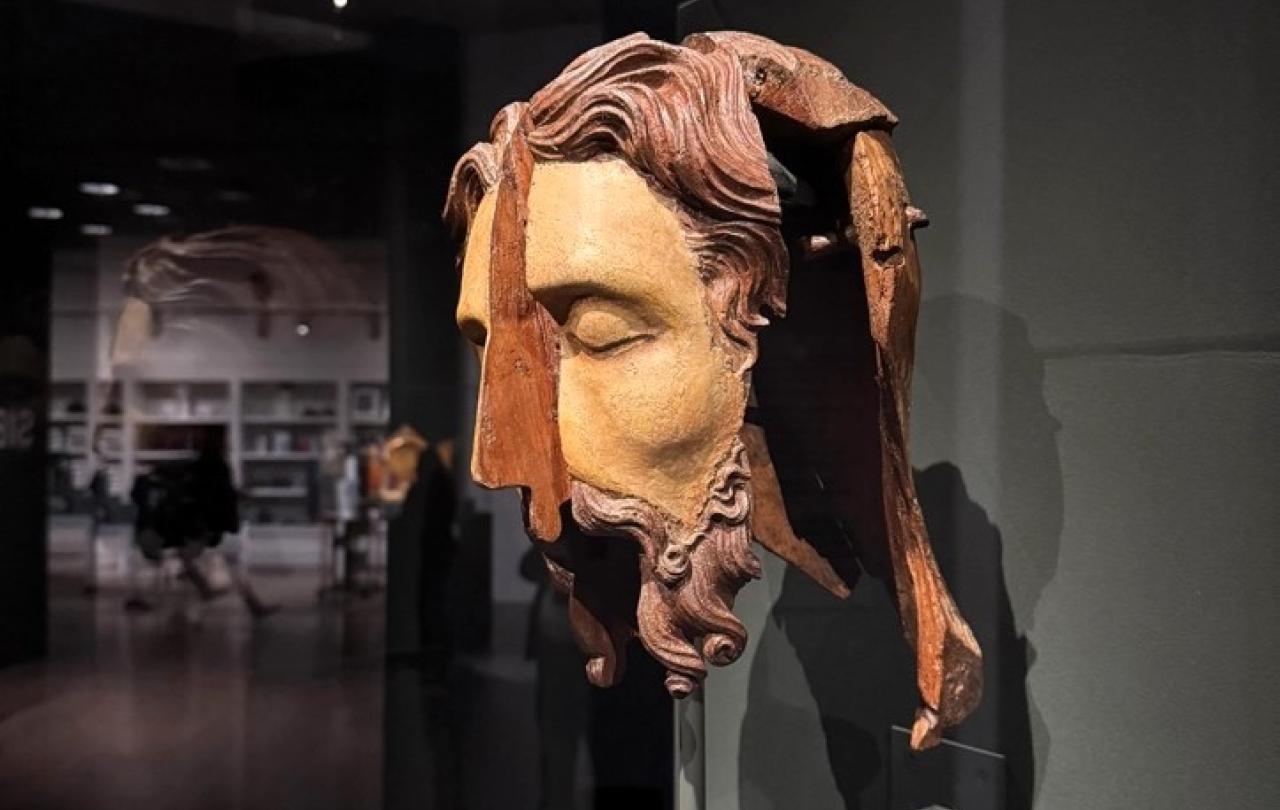
Curating an art exhibition about the emergence of recognisably life like painting and sculpture, pre-supposes just one thing. That the once innovative and venerated art works survive to today, even if shorn of their original, usually religious, settings. Those that made it to the National Gallery’s Siena: The Rise of Painting 1300-1350 have some tales to tell. That give us insight into their creators and their beliefs.
A cracked skull is sadly not an unusual find in the aftermath of an explosion. But the head discovered in the rubble of a Siena church following a World War Two Allied bombing raid in 1944 was remarkable. Almost life-sized, made of walnut and depicting Christ’s face, the carving had originally been part of the figure on a crucifix, but now severed from its body, the head was almost sheered in two. From this destruction spilled more secrets.
Hidden inside the skull, its creator Lando di Pietro inserted parchment with personal prayers. What little documentation we have about 14th century artists is usually public: contracts, lawsuits and wills, but these two scraps of writing represented Pietro’s personal faith. He dramatically asserted himself as the creator of the work:
“Lord God made it possible for Lando di Pietro of Siena to sculpt this cross from wood in the likeness of the true Jesus Christ to recall for people the Passion of Jesus Christ…have mercy on all generations”
And Lando also prayed for good health and for the world.
The fragment of a crucifix dating from 1338, is the only surviving example of wooden sculpture by this renowned goldsmith and architect, one of the Trecento creators on display at Siena: The Rise of Painting 1300-1350. In the hothouse of creativity that was the Tuscan town in the first half of the 14th century, goldsmiths collaborated with sculptors and painters, and the images they collectively created inspired manuscript illuminators, whose works, passing through many hands, went on to inspire other artists.
Siena’s position on the Via Francigena, the major pilgrim route between northern Europe and Rome, ensured the city’s artistic innovations spread to Britain and eastern Europe and beyond. And Sienese painter Simone Martini’s patronage by cardinals and members of the Papal curia in the Pope’s court at Avignon, showcased the techniques, materials and styles of Siena to influential church leaders and royal courts throughout the Catholic communion. Interconnected through marriage and diplomacy, the courts of northern Europe would have diffused Sienese style through the exchange of gifts, and hosting and commissioning peripatetic artists from the city.
The portability of devotional objects also spread the developments of Siena’s more naturalistic and emotional style, way beyond the city’s boundaries.
Decorative crosiers would have been in motion during processions, and the sculptural decoration contained in their curved tops were viewed in the round. On the Master of San Galgano Crosier, about 1315-20, the cast figure of the saint kneels in front of his makeshift cross. St Galgano’s praying hands and bent elbows form a perfect line with the sheathed sword, that the twelfth century knight miraculously drove into a rock. The Abbey of San Galgano grew up near the site of the miracle, and the intricately decorated reliquary containing the saint’s head is faithfully reproduced in enamel at the top of the staff.
Simone Martini’s Orsini Polyptych, dating from around 1310, can be understood as a freestanding, miniature, double sided altarpiece, depicting a silent Annunciation on one side, and a tumultuous Passion cycle on the other. The polyptych’s probable patron, Cardinal Napoleone Orsini is portrayed at the foot of the cross in the Deposition. Fully closed for transportation, the eight panels resemble a block of marble encased in gold. With the outer wings closed, the marble ‘covers’ become a setting for an Annunciation diptych. Fully opened, the panels tell the Passion, story Christ’s torture and death.
Originally the panels were likely hinged together, so the work could fold like a concertina. After a period at the Papal curio in Avignon, the panels were separated centuries ago. Seeing the panels individually lost the tangibility of the object’s manipulation of space, through folding and portability. Seeing them united in the National Gallery for the first time in centuries is incredibly moving.
An early fifteenth century French prayer book The Belles Heures of Jean de France, Duc de Berry, has a Lamentation scene sharing many motifs with the Orsini Polyptych, including the woman tearing at her hair, Saint John the Evangelist covering his eyes, and the back view of Mary Magdalene crouching over Christ’s feet. Within a hundred years, the Sienese emphasis on human emotion and portraying figures in recognisably three-dimensional space, had rippled out to other art forms and other countries.
One of Britain’s medieval treasures, the Wilton Diptych, commissioned by Richard II about a decade earlier than Berry book of hours, also reveals the influence of Siena: from the king’s animated pose kneeling before the Virgin and Child, to the egg tempera paint, and gold leaf sgraffito, where the surface is scratched away to depict sumptuous textiles.
In an exhibition full of showstoppers, the unification of the back predella (altarpiece base) of Duccio’s Maestra altarpiece is a standout moment. Installed in Siena Cathedral in 1311, Maestra has the oldest surviving narrative predella. On the front, depicting the Virgin Mary at the centre of a heavenly court, the painter had included his signature and a prayer.
“Holy Mother of God, bring peace to Siena, and bring life to Duccio who painted you like this.”
While the front image of the heavenly court would have been viewed from afar, the congregation could move close to the back predella and view a sequence of panels on Christ’s teaching and miracles as they prayed.
In 1771 the Maestra was sawn in half, and the predella dismantled. Its individual scenes were dismantled and displayed, and then sold, separately. The eight surviving panels are reunited in the National Gallery for the first time in 250 years.
The Black Death struck Siena in 1348, killing up to half its population, including many artists. Over centuries, plague, war, differences of religious doctrine, and fashion for Grand Tour mementoes, saw objects dismembered and repurposed. Yet the emotional resonance of maternal love seen in Ambrogio Lorenzetti’s Madonna del Latte, c.1325 or the humanising family drama of Simone’s last surviving work, Christ Discovered in the Temple, 1342, could never be undone. Art grounded in human emotions and human perceptions of the spaces around us, was here to stay,
The wartime work of the Monuments, Fine Arts, and Archives (MFAA) unit in preserving treasures such as the Head of Christ found in the ruins of the Basilica di San Bernadino all’Osservanza, was dramatised in George Clooney’s 2014 film Monuments Men. Creativity’s boundless resistance to the forces of destruction will always be box office.
Siena: The Rise of Painting 1300 -1350 National Gallery, until 22 June.
Support Seen & Unseen
Since Spring 2023, our readers have enjoyed over 1,000 articles. All for free.
This is made possible through the generosity of our amazing community of supporters.
If you enjoy Seen & Unseen, would you consider making a gift towards our work?
Do so by joining Behind The Seen. Alongside other benefits, you’ll receive an extra fortnightly email from me sharing my reading and reflections on the ideas that are shaping our times.
Graham Tomlin
Editor-in-Chief





